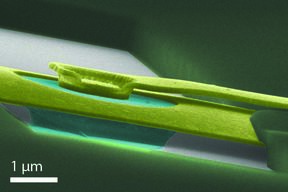First confirmation of a Wigner crystal in graphene paves the way for a new kind of quantum computing

In the 1930s, the Nobel Prize winner Eugen Wigner predicted the discovery of the Wigner crystal, and Aalto University researchers succeed now for the first time in observing a Wigner crystal in graphene using a number of different measurement techniques. The research is carried out using freely suspended graphene in which a film with a thickness of one atomic layer is supported only by its edges.
A Wigner crystal is an ordered phase produced by the repelling electrical interactions of electrons. In low temperatures and strong magnetic fields, the electrons of a two-dimensional sparse electron gas can become fixed in place, forming solid crystallites or even a lattice.
Forming a Wigner crystal in graphene enables a new platform that can be used to study a system of correlated electrons. Possible applications for this include quantum computing. Given the correct conditions, freely suspended graphene can enable braiding – the transfer of particles from one place to another and around each other – in a similar way to that which Microsoft researchers are planning to do with Majorana particles.
“The end result of braiding depends on how the transfers are done. The braiding of particles called anyons that remain in the middle ground between bosons and fermions create a phase shift in the quantum-mechanical wave function, and this property can be used in quantum computing”, explains Postdoctoral Researcher Antti Laitinen.
Antti LaitinenThe end result of braiding depends on how the transfers are done.
Freely suspended graphene can also be used in ultra-sensitive gas detectors, but the mainstreaming of such devices is limited by the special processing required and the difficulties in maintaining the free suspension of the graphene. The strong electron-electron interaction makes freely suspended graphene an attractive platform for the research of changes to two-dimensional correlated configurations and the discovery of emergent particles that form in the new, ordered phases.
Strong interactions between electrons
The suspended graphene devices being studied in the Aalto University experiments make use of Corbino geometry, in which a tyre-shaped graphene slice with a thickness of one atomic layer is supported by its outer and inner edge using metal electrodes. Between the edges, the graphene is freely suspended. This geometry enables the study of the graphene’s current and voltage in strong magnetic fields without the edges influencing the conductivity.
Earlier on, it has only been possible to study Wigner crystal using Gallium Arsenide-based solid-state devices, in which a flat, two-dimensional electron gas is made using precise atomic layering. Graphene, on the other hand, is naturally wrinkled and unordered – stability is achieved in the study by the graphene being fixed at the edges. The research revealed stronger interactions between electrons then had been previously observed.
“The temperature for the ordering of the Wigner crystal is around one kelvin, which is significantly higher than for the normal semiconductor-based Wigner crystals. The interaction is stronger in the system, because it does not have any substrate material which would weaken the interactions between the electrons”, explains Aalto University Professor Pertti Hakonen.
The weakening of the interactions in the semiconducting devices is a consequence of the positive charge which accumulates in the substrate, causing it to attract the electrons. This effect cannot be separated from the direct, repelling electron-electron interaction.
Further information:
Otaniemi research infrastructure for micro- and nanotechnologies (OtaNano)
Picture: Electron microscope image from the Corbino device: it is observed that an electron lattice, a two-dimensional Wigner crystal composed of around 20 crystals forms in the graphene that is marked green. Image: Antti Laitinen.
Read more news

A new way to measure contagion: the gut bacterium behind blood poisoning can spread like influenza
Neither the antibiotic-resistant nor the highly virulent strains are the most transmissible.Tonmoy Saha Presents Textile Recycling Research at CIMANET Seminar
The CIMANET Research Seminar, held under the theme “Future Leaders in Circular Materials Bioeconomy,” took place on Thursday, December 4, at the Scandic Marina Congress Center in Helsinki.
Textile Chemistry Group Meeting Held
The Annual Meeting of The Textile Chemistry Group held on Thursday, December 11, uniting researchers, doctoral candidates, master’s students, and interns to present their advances in sustainable textile technologies.






